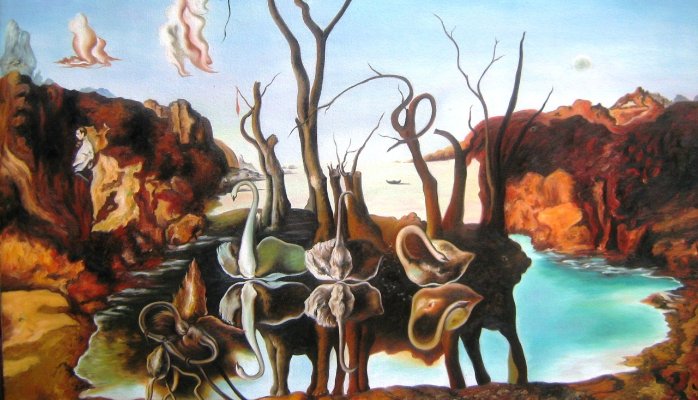This is the fourth part of a guest post series by Nuno Gaspar de Oliveira who works as consultant and advisor in Esporão, a portuguese main wine and olive oil company, in the area of Strategic Management for sustainability using ‘Business Ecosystems’ models,
This guest post has previously been published on LinkedIn. It is the expression of the author’s thoughts and experiences and as such is acknowledged as a fruitful contribution to the discussion on biodiversity offsets. If you want to react or clarify your own position (underpin or disprove), please leave a reply below!
Ernst Friedrich (EF) Schumacher was born in Germany in 1911 but had most of his higher education in England, partly because he dreaded the rising of Nazism. His German ascendency brought him a fair share of problems with the British government during the war years, but his sophisticated knowledge of economics didn’t past unnoticed and after the War, Schumacher worked as an advisor to the British Control Commission charged with rebuilding the German economy. During 20 years he worked in the coal industry, gaining enormous experience in the complex issues of macroeconomics and geopolitics.
Yet, in 1955 an odd deal got him an experience of a lifetime, a project in Burmabrought him closer to the ancient religion and philosophy of Buddhismand that, how unexpected it might seem to most of our days macroeconomists,provided indeed illumination.
During this mission, he developed the belief that good work was essential for proper human development and that “production from local resources for local needs is the most rational way of economic life” – ‘Buddhist Economics’ was then to become one of his masterpieces.
A few years later, under the influence of great thinkers from Keynes to Gandhi wrote ‘Small is Beautiful: Economics as if People mattered’ (1973). In his seminal work, Schumacher elaborates further on the problem of technological production being associated with abusive property rights and boundless use and degradation of finite natural capital thus depriving future generations of future options and benefits. Schumacher’s thoughts dwelled deep into the sole nature of economics and human wellbeing, and ‘standing on the shoulders of giants’, produced some very powerful statements such as:
“Modern man does not experience himself as a part of nature but as an outside force destined to dominate and conquer it. He even talks of a battle with nature, forgetting that, if he won the battle, he would find himself on the losing side. Until quite recently, the battle seemed to go well enough to give him the illusion of unlimited powers, but not so well as to bring the possibility of total victory into view. This has now come into view, and many people, albeit only a minority, are beginning to realize what this means for the continued existence of humanity.”
While Schumacher was ‘in between books’, something was happening amidst the spring of 68’ where once was the home of the Roman Empire. The ‘Club of Rome’ was forged mostly by inspiration of independent thinkers, men and women coming from such different fields as politics, business and science, motivated to develop a new vision of a better world where economics and the Earth systems and resources where on the same side of the story.
In short, the members of the Club of Rome were mostly focused on identifying problems which might determine the future of humanity, develop prospective analysis and scenarios and propose ideas and solutions to solve them (or at least not to aggravate them).
In 1972, a brilliant dynamic woman named Donella ‘Dana’ Meadows, an American Ph.D. in biophysics from Harvard and a research fellow at MIT, was on a team working on one of the first global computer models, this one was called “World3″ and the ‘contractor’ was the Club of Rome. Meadows was very excited (and maybe a little terrified) by the outcomes of the model and leaded the team to write one of the most impacting – and controversial — reports of the 20th century.
‘The Limits to Growth’ dared to expose scenarios based on the interactions of five global economic subsystems, namely population, food production, industrial production, pollution, and consumption of non-renewable natural resources. Although limited by (then) current knowledge and information technology restrictions the LTG team stated that:
“If the present growth trends in world population, industrialization, pollution, food production, and resource depletion continue unchanged, the limits to growth on this planet will be reached sometime within the next 100 years. The most probable result will be a rather sudden and uncontrolled decline in both population and industrial capacity.”
30 years later, the team once more coordinated by Dana Meadows would release the book ‘The limits to growth: the 30-year update’ (2004) reaffirming that the symptoms of a world overshoot where resources where either depleted or degraded much faster than it could be restored by the Earth’s natural systems are at the base of the global environmental, social and economic collapse…
Back to the 70’s.
The tide of geopolitical unsteadiness, powered by the ever increasing influence of ‘dinosaur pâté’ (term coined by ‘Calvin & Hobbes’), a.k.a., oil. Yet, sailing the winds of (economic) change powered by Odum, Hardin, Georgescu-Roegen, Schumacher, Meadows et al., Herman Daly, an American economist, nowadays recognized as one of the founders of the field of ecological economics and as a critic of standard economic growth theory, dared to be one of the first economists to look deeply into the relationship of the economy and the environment.
In his proposal for a ‘Steady State Economy’ (1977), Daly applied classical concepts of capital and income to resources and the environment, the laws of thermodynamics, and the insights of ecology, particularly in relation to levels of flows of materials and energy through economic systems, providing one of the most quoted insights regarding the balance between natural capital and the economic system:
“The economy is a wholly owned subsidiary of the environment, not the reverse”
Quite simple and, let’s face it, obvious, right? And yet, still we argue…
Daly introduced the concepts of isolated systems and closed biosphere into the post-modern economic thinking and launched the ‘empty world / full world’ theory, nowadays still largely misunderstood by what Daly called ‘growthists’.
It became evident that, without natural capital, namely biodiversity and ecosystem services and functions there would not be a support for human societies, thus, no support for an economic system.
That obvious.
Many authors came after Daly’s Steady-State hypothesis and built an even stronger case for the role of natural capital as the very foundation for the economic system.
The combination of Daly’s breakthroughs with the 1974 ‘utilitarian’ modeldeveloped by a combination of works by Sollow, Dasgupta and Stiglitz (e.g., Dasgupta & Heal, 1974; Solow, 1974 and Stiglitz, 1974) provided a description of an economy with two assets, man-made capital and a non-renewable resource stock.
Together with man-made capital the raw material from the resource is used as an input in the production of a commodity that can be used forconsumption and for net investments in man-made capital.
This ‘utilitarian’ view of capital-resources-production still is largely common these days. Yet, another major turn was about to occur…
Some References
Daly, H. E. (1977). Steady-state economics. San Francisco.
Dasgupta, P., & Heal, G. (1974). The optimal depletion of exhaustible resources.The review of economic studies, 3–28.
Meadows, D. H., Meadows, D., Randers, J., & Behrens III, W. W. (1972). The Limits to Growth: A Report for the Club of Rome’s Project on the Predicament of Mankind (New York: Universe).
Schumacher, E. F. (1973). Small is beautiful: Economics as if people really mattered. Abacus, London, 64.
Solow, R. M. (1974). The economics of resources or the resources of economics.The American Economic Review, 1–14.
Stiglitz, J. E. (1974). Growth with Exhaustible Natural Resources: The Competitive Economy. Review of Economic Studies, 41(5).

